A Big Data-Driven Approach for Early Warning of Enterprise Emissions Alignment with Carbon Neutrality Targets: A Case Study of Guangxi Province
Abstract
:1. Introduction
- By integrating enterprise electricity consumption big data, we constructed a four-tier carbon quota allocation model at the levels of national–provincial–industrial–enterprise.
- Integrating carbon intensity factors, we utilized electricity big data to estimate enterprise carbon emissions. Subsequently, we developed a Carbon Neutrality Index to depict the disparity between actual enterprise carbon emissions and the carbon neutrality pathway.
- We designed an enterprise carbon emission early warning method, determined the warning thresholds, and divided the warning levels to achieve the objectives of dynamically regulating key enterprises.
2. Methodology
2.1. National–Provincial–Industrial–Enterprise Carbon Quota Allocation System
2.1.1. National–Provincial Carbon Quota Allocation
2.1.2. Provincial–Industrial Carbon Quota Allocation
2.1.3. Industrial–Enterprise Carbon Quota Allocation
2.2. Enterprise Carbon Emission Early Warning Model
2.2.1. Enterprise Carbon Neutrality Index
2.2.2. Enterprise Carbon Emission Early Warning Method
3. Data
4. Results and Discussion
4.1. Pathways to Carbon Neutrality in China
4.2. Provincial Carbon Quota Allocation Results
4.3. Carbon Quota Allocation across Industries in Guangxi
4.4. Guangxi Enterprise Carbon Neutrality Index
4.5. Guangxi Enterprise Carbon Emission Early Warning Levels
5. Conclusions and Implications
5.1. Conclusions
- The carbon-neutral pathways studied by various institutions can be categorized into two types. One type involves a gradual reduction in carbon emissions, starting from 2020, without a specific peak emission point, while the other type sees a peak in carbon emissions from 2024 to 2028, followed by a rapid decline. However, regardless of the carbon-neutral pathway adopted, both indicate that China’s journey towards carbon neutrality is challenging and requires early planning, as well as proactive actions from all participating entities.
- From the results of carbon quota allocation by province, there is a notable difference in the allocation for 2020, with regions like Guangdong receiving the highest quota of 606 million tons, constituting 5.72% of the national carbon quota. In contrast, Guangxi is allocated only 263 million tons, 26% below the average quota. Concerning industrial carbon quota allocation, owing to its historically highest carbon emissions across all industries, Guangxi’s electric power, steam, and hot water production and supply sector secures 90.36 million tons of carbon quota, accounting for 34% of the total regional carbon allocation in Guangxi.
- The Carbon Neutrality Index of key enterprises in Guangxi in 2020 indicates that there is still significant room for improvement in reducing carbon emissions among enterprises in the region. Approximately 60.66% of enterprises have a Carbon Neutrality Index greater than 1, failing to meet the carbon neutrality standard. Around 39.34% of enterprises are able to achieve carbon neutrality goals. In addition, 8.79% of enterprises have a Carbon Neutrality Index ranging from 0.75 to 1.00. While these enterprises just meet the carbon neutrality standard, the rising electricity demand due to economic growth may lead to their carbon emissions surpassing allocated quotas.
- Based on the carbon emission warning levels of key enterprises in Guangxi in 2021, there is a clear trend of emission reduction among Guangxi enterprises. Over 90% of enterprises are actively implementing emission reduction measures, with more than half of them being recognized as being at the Commendation level, and 36.77% of enterprises being awarded the Encouragement level. Only 9.17% of enterprises are rated as Warning, and 0.21% are rated as Reminder. Overall, while Guangxi enterprises still face emission reduction challenges, it is progressing towards sustainable development.
5.2. Implications
- Estimates on the pathways to carbon neutrality from all institutes indicate that China faces severe challenges in achieving carbon neutrality. The government needs to deploy policies and plan in advance to ensure the smooth achievement of China’s carbon neutrality goal. Initially, it is suggested that the government increase investment in carbon emission control, as early successful reductions would be a crucial step towards achieving the target. In the medium term, the government should accelerate the exploitation and use of clean energy and encourage industries to improve energy efficiency levels to ensure cleaner, more efficient, and economical energy supply and consumption. In the later stage, the government is recommended to support the research, development, and application of carbon sink and carbon sequestration technologies to make substantial progress in deep decarbonization.
- To alleviate the emission reduction pressure on high-carbon industries and enterprises, carbon emission control policies should be formulated based on the characteristics of each emission entity. At the industry level, it is recommended that carbon emission control targets be established according to the historical carbon emissions of each industry. Industries with significant carbon reduction pressure should be given special attention, supporting them in achieving technological upgrades and transitioning to clean energy sources. At the enterprise level, implement stricter monitoring and emission reduction requirements for enterprises with a Carbon Neutrality Index greater than 1, and take corresponding measures to encourage their proactive emission reduction efforts.
- In conjunction with the dynamic control and early warning levels of enterprise carbon emissions, a series of targeted policies could be formulated to better achieve carbon neutrality targets for enterprises in Guangxi. On one hand, for enterprises with the Commendation and Encouragement early warning level, strengthen the reward system and set up special funds to incentivize more enterprises to participate actively in emission reduction. On the other hand, provide technical support and training for enterprises at the Reminder and Warning level to help them improve emission reduction techniques and ensure better compliance with carbon quotas in the future.
Author Contributions
Funding
Data Availability Statement
Conflicts of Interest
Appendix A. The Calculation of Industry Carbon Quota Allocation
| Industry | Carbon Emissions (Thousands of Tons) |
|---|---|
| Electric power, steam, and hot water production and supply | 90,363.66 |
| Nonmetal mineral products | 52,126.65 |
| Smelting and pressing of ferrous metals | 40,172.04 |
| Smelting and pressing of nonferrous metals | 32,377.78 |
| Transport, storage, postal, and telecommunications services | 21,715.46 |
| Raw chemical materials and chemical products | 5896.58 |
| Food processing | 4012.46 |
| Petroleum processing and coking | 3716.94 |
| Farming, forestry, animal husbandry, fishery, and water conservancy | 3159.03 |
| Wholesale, retail trade, and catering service | 2086.43 |
| Papermaking and paper products | 1880.62 |
| Beverage production | 909.83 |
| Other | 868.49 |
| Transportation equipment | 505.38 |
| Construction | 384.55 |
| Medical and pharmaceutical products | 312.61 |
| Food Production | 274.36 |
| Ferrous metals mining and dressing | 256.38 |
| Plastic products | 245.49 |
| Gas production and supply | 234.15 |
| Metal products | 229.11 |
| Textile industry | 220.89 |
| Ordinary machinery | 174.84 |
| Nonferrous metals mining and dressing | 173.64 |
| Timber processing; bamboo, cane, palm, and straw products | 168.01 |
| Rubber products | 166.95 |
| Nonmetal minerals mining and dressing | 122.44 |
| Coal mining and dressing | 89.04 |
| Equipment for special purpose | 86.32 |
| Electric equipment and machinery | 46.03 |
| Tobacco processing | 42.60 |
| Leather, furs, down, and related products | 42.48 |
| Other manufacturing industry | 41.56 |
| Scrap and waste | 11.04 |
| Electronic and telecommunications equipment | 8.12 |
| Tap water production and supply | 6.11 |
| Printing and record medium reproduction | 5.18 |
| Furniture manufacturing | 4.53 |
| Garments and other fiber products | 2.40 |
| Chemical fiber | 1.46 |
| Instruments, meters cultural, and office machinery | 1.04 |
| Cultural, educational, and sports articles | 0.41 |
| Other minerals mining and dressing | 0.06 |
| Petroleum and natural gas extraction | 0.00 |
| Logging and transport of wood and bamboo | 0.00 |
References
- Shi, H.; Chai, J.; Lu, Q.; Zheng, J.; Wang, S. The impact of China’s low-carbon transition on economy, society and energy in 2030 based on CO2 emissions drivers. Energy 2022, 239, 122336. [Google Scholar] [CrossRef]
- Xu, S. China’s climate governance for carbon neutrality: Regulatory gaps and the ways forward. Hum. Soc. Sci. Commun. 2023, 10, 853. [Google Scholar] [CrossRef]
- He, W.; Zhang, B.; Li, Y.; Chen, H. A performance analysis framework for carbon emission quota allocation schemes in China: Perspectives from economics and energy conservation. J. Environ. Manag. 2021, 296, 113165. [Google Scholar] [CrossRef] [PubMed]
- Hong, Y.; Jiang, X.; Xu, H.; Yu, C. The impacts of China’s dual carbon policy on green innovation: Evidence from Chinese heavy-polluting enterprises. J. Environ. Manag. 2024, 350, 119620. [Google Scholar] [CrossRef] [PubMed]
- Liu, Z.; Guan, D.; Wei, W. Carbon emission accounting in China. Sci. China Earth 2018, 48, 878–887. (In Chinese) [Google Scholar]
- Qian, H.; Xu, S.; Cao, J.; Ren, F.; Wei, W.; Meng, J.; Wu, L. Air pollution reduction and climate co-benefits in China’s industries. Nat. Sustain. 2021, 4, 417–425. [Google Scholar] [CrossRef]
- Pan, J. Construction, challenges and marcket expansion of emissions trading system. Chin. J. Popul. Resour. Environ. 2016, 26, 1–5. (In Chinese) [Google Scholar]
- Xie, M.; Liu, X.; Yan, W.; Li, Y.; Liu, X.; Zhang, G.; Sun, J. Carbon emission reduction pathways under carbon neutrality targets in Gansu province of China. Front. Environ. Sci. 2022, 10, 1042344. [Google Scholar] [CrossRef]
- Zhang, D.; Huang, X.D.; Zhong, J.T.; Guo, L.-F.; Guo, S.-Y.; Wang, D.-Y.; Miao, C.-H.; Zhang, X.L.; Zhang, X.Y. A representative CO2 emissions pathway for China toward carbon neutrality under the Paris Agreement’s 2 °C target. Adv. Clim. Chang. Res. 2023, 14, 941–951. [Google Scholar] [CrossRef]
- Fan, X. Enightenments of the intemational ealy waming system to domestic environmental eany waning research. Acta Ecol. Sin. 2021, 41, 7454–7463. [Google Scholar]
- Neußner, O. Early warning alerts for extreme natural hazard events: A review of worldwide practices. Int. J. Disaster Risk Reduct. 2021, 60, 102295. [Google Scholar] [CrossRef]
- Xu, Y.; Guo, J. Construction safety early warning simulation based on risk conduction BN model. Comput. Simul. 2024, 41, 527–531. (In Chinese) [Google Scholar]
- Li, J.; Wang, L.; Wang, J. Based on dynamic critical rainfall of the mountain torrent disaster early warning technology research. J. Nat. Disasters 2023, 32, 235–242. (In Chinese) [Google Scholar]
- Sun, P.; Wu, K. Based on data fusion of large passenger flow in urban rail transit early warning research. Electron. Des. Eng. 2024, 32, 135–139. (In Chinese) [Google Scholar]
- Huang, Z.; Wu, C.; Chen, Z. Research on safety early warning of petrochemical Enterprises based on AHP-BP neural network method. Ind. Saf. Environ. Prot. 2021, 47, 1–6. (In Chinese) [Google Scholar]
- Sättele, M.; Bründl, M.; Straub, D. Quantifying the effectiveness of early warning systems for natural hazards. Nat. Hazards Earth Syst. Sci. 2016, 16, 149–166. [Google Scholar] [CrossRef]
- Liang, Y.; Niu, D.; Wang, H.; Chen, H. Assessment Analysis and Forecasting for Security Early Warning of Energy Consumption Carbon Emissions in Hebei Province, China. Energies 2017, 10, 391. [Google Scholar] [CrossRef]
- Zhao, G. Research on measurement and early warning of carbon emissions from China’s export trade. Ecol. Econ. 2018, 34, 19–24. (In Chinese) [Google Scholar]
- Cui, J.; Xu, B.; Han, J. Construction of carbon emission early warning index system based on Folksonomy and ontology modeling. Inf. Sci. 2013, 31, 126–129. (In Chinese) [Google Scholar]
- Han, S.; Zhu, M.; Liu, H. Research on carbon emission monitoring and early warning system: Based on the analysis of provincial data in China. Ecol. Econ. 2012, 38, 21–27. (In Chinese) [Google Scholar]
- Kawamoto, K.; Shimoda, Y.; Mizuno, M. Energy saving potential of office equipment power management. Energy Build. 2004, 36, 915–923. [Google Scholar] [CrossRef]
- Cong, R.; Han, J. Research on carbon emission early warning evaluation of China’s thermal power plants based on artificial neural network—A case study of a thermal power plant in Jilin Province. Ecol. Econ. 2019, 35, 37–41. (In Chinese) [Google Scholar]
- Zhou, Z.; Xiao, T. Based on support vector machine (SVM) carbon polluting industries risk early warning research. Environ. Pollut. Control 2016, 38, 82–89. (In Chinese) [Google Scholar]
- Xin, D. Research on Measurement and Early Warning of Carbon Emission of China’s Agricultural Export Products. Master’s Thesis, North China Electric Power University, Beijing, China, 2019. (In Chinese). [Google Scholar]
- Jin, H.; Chen, Y.; Zhang, L. Research on carbon emission monitoring and early warning system based on blockchain. Econ. Res. Guide 2023, 36–38. (In Chinese) [Google Scholar]
- Peng, Y. Research and Design of Distributed WebGIS Carbon Emission Early Warning and Decision System. Master’s Thesis, Central South University, Hunan, China, 2012. (In Chinese). [Google Scholar]
- Zhang, Y.-J.; Hao, J.-F.; Song, J. The CO2 emission efficiency, reduction potential and spatial clustering in China’s industry: Evidence from the regional level. Appl. Energy 2016, 174, 213–223. [Google Scholar] [CrossRef]
- Du, K.; Zou, C. Regional differences, influencing factors and convergence analysis of carbon emission efficiency in China: An empirical study based on stochastic frontier model and panel unit root. Zhejiang Soc. Sci. 2011, 32–43. (In Chinese) [Google Scholar]
- Battese, G.E.; Coelli, T.J. A Model for Technical Inefficiency Effects in a Stochastic Frontier Production Function for Panel Data. Empir. Econ. 1995, 20, 325–332. [Google Scholar] [CrossRef]
- Cong, R.; Lo, A.Y. Emission trading and carbon market performance in Shenzhen, China. Appl. Energy 2017, 193, 414–425. [Google Scholar] [CrossRef]
- Li, F.; Wu, F.P.; Chen, L.X. Harmonious allocation of carbon emission permits based on dynamic multiattribute decision-making method. J. Clean. Prod. 2020, 248, 119184. [Google Scholar] [CrossRef]
- Liu, L.; Chen, C.; Zhao, Y.; Zhao, E. China׳s carbon-emissions trading: Overview, challenges and future. Renew. Sustain. Energy Rev. 2015, 49, 254–266. [Google Scholar] [CrossRef]
- Ye, F.; Fang, X.; Li, L.; Li, Y.; Chang, C.-T. Allocation of carbon dioxide emission quotas based on the energy-economy-environment perspective: Evidence from Guangdong Province. Sci. Total Environ. 2019, 669, 657–667. [Google Scholar] [CrossRef] [PubMed]
- Chen, H.; Wang, R.; Liu, X.; Du, Y.; Yang, Y. Monitoring the enterprise carbon emissions using electricity big data: A case study of Beijing. J. Clean. Prod. 2023, 396, 136427. [Google Scholar] [CrossRef]
- Chen, H.; Gong, K.; Chang, Y.; He, W.; Geng, H.; Zhang, B.; Zhang, W. Modeling the power system resilience in China under different natural disasters. J. Environ. Manag. 2023, 347, 119151. [Google Scholar] [CrossRef]
- Chen, H.; Jin, L.; Wang, M.; Guo, L.; Wu, J. How will power outages affect the national economic growth: Evidence from 152 countries. Energy Econ. 2023, 126, 107055. [Google Scholar] [CrossRef]
- Zhou, C.; Lin, X.; Wang, R.; Song, B. Real-Time Carbon Emissions Monitoring of High-Energy-Consumption Enterprises in Guangxi Based on Electricity Big Data. Energies 2023, 16, 5124. [Google Scholar] [CrossRef]
- Shan, Y.; Guan, D.; Zheng, H.; Ou, J.; Li, Y.; Meng, J.; Mi, Z.; Liu, Z.; Zhang, Q. China CO2 emission accounts 1997–2015. Sci. Data 2018, 5, 170201. [Google Scholar] [CrossRef] [PubMed]
- Shan, Y.; Huang, Q.; Guan, D.; Hubacek, K. China CO2 emission accounts 2016–2017. Sci. Data 2020, 7, 54. [Google Scholar] [CrossRef] [PubMed]
- Guan, Y.; Shan, Y.; Huang, Q.; Chen, H.; Wang, D.; Hubacek, K. Assessment to China’s Recent Emission Pattern Shifts. Earth’s Future 2021, 9, e2021EF002241. [Google Scholar] [CrossRef]
- Shan, Y.; Liu, J.; Liu, Z.; Xu, X.; Shao, S.; Wang, P.; Guan, D. New provincial CO2 emission inventories in China based on apparent energy consumption data and updated emission factors. Appl. Energy 2016, 184, 742–750. [Google Scholar] [CrossRef]
- Xu, J.; Guan, Y.; Oldfield, J.; Guan, D.; Shan, Y. China carbon emission accounts 2020–2021. Appl. Energy 2024, 360, 122837. [Google Scholar] [CrossRef]
- Energy Foundation China. Synthesis Report 2020 on China’s Carbon Naturality. 2020. Available online: https://www.efchina.org/Attachments/Report/report-lceg-20201210 (accessed on 10 December 2020).
- Yu, B.; Zhao, G.; An, R.; Chen, J.; Tan, J.; Li, X. Carbon neutral targets under China’s carbon emissions way research. J. Beijing Inst. Technol. (Engl. Ed.) 2021, 23, 17–24. (In Chinese) [Google Scholar]
- Project Comprehensive Report Compilation Group; Tsinghua University. Comprehensive report on China’s Long-term low-carbon Development Strategy and Transition Path. China Popul. Resour. Environ. 2020, 30, 1–25. (In Chinese) [Google Scholar]
- Cai, B.; Cao, L.; Lei, Y.; Wang, C.; Zhang, L.; Zhu, J.; Li, M.; Du, M.; Lv, C.; Jiang, H.; et al. Carbon dioxide emission path under China’s carbon neutrality goal. China Popul. Resour. Environ. 2019, 31, 7–14. (In Chinese) [Google Scholar]
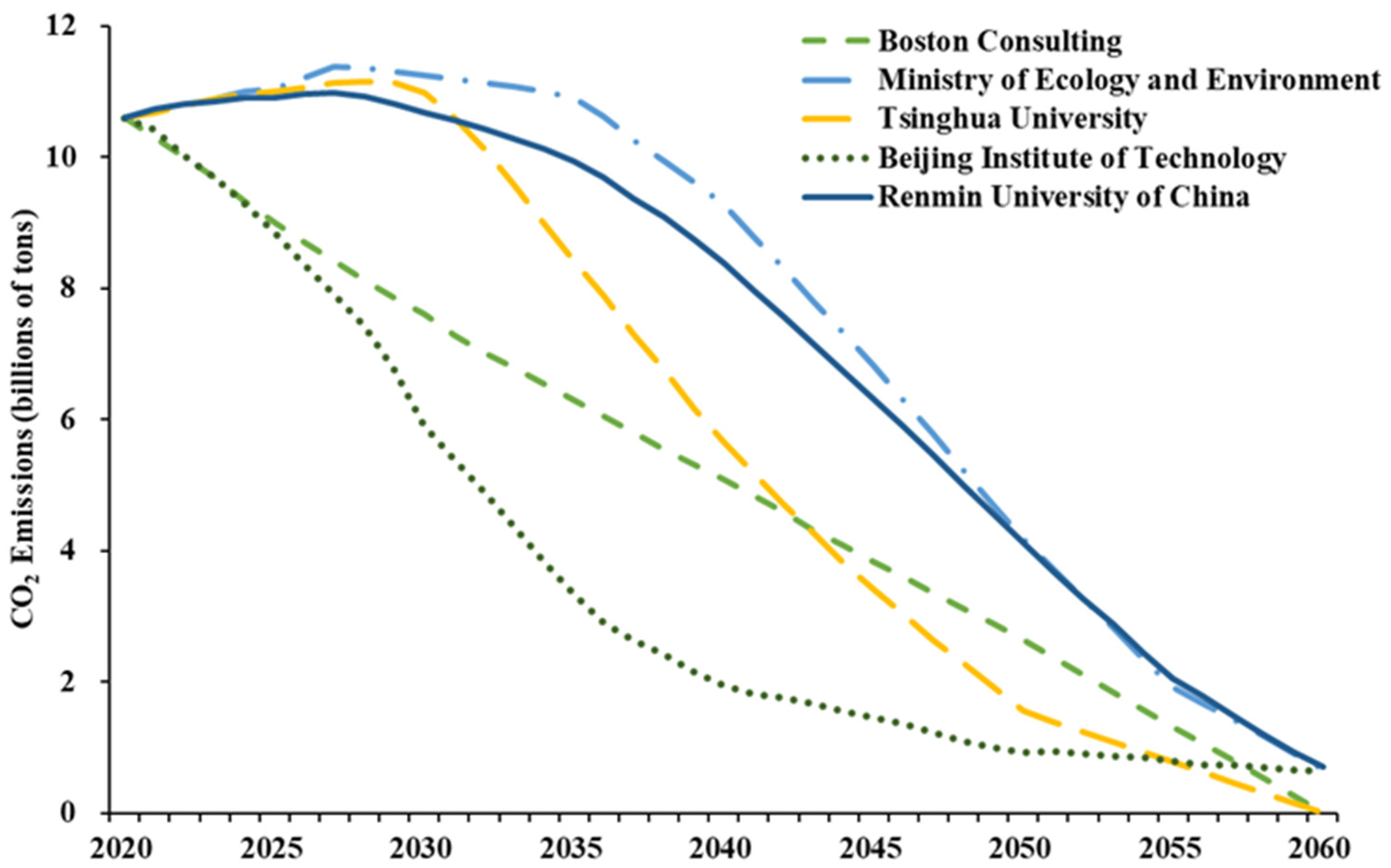
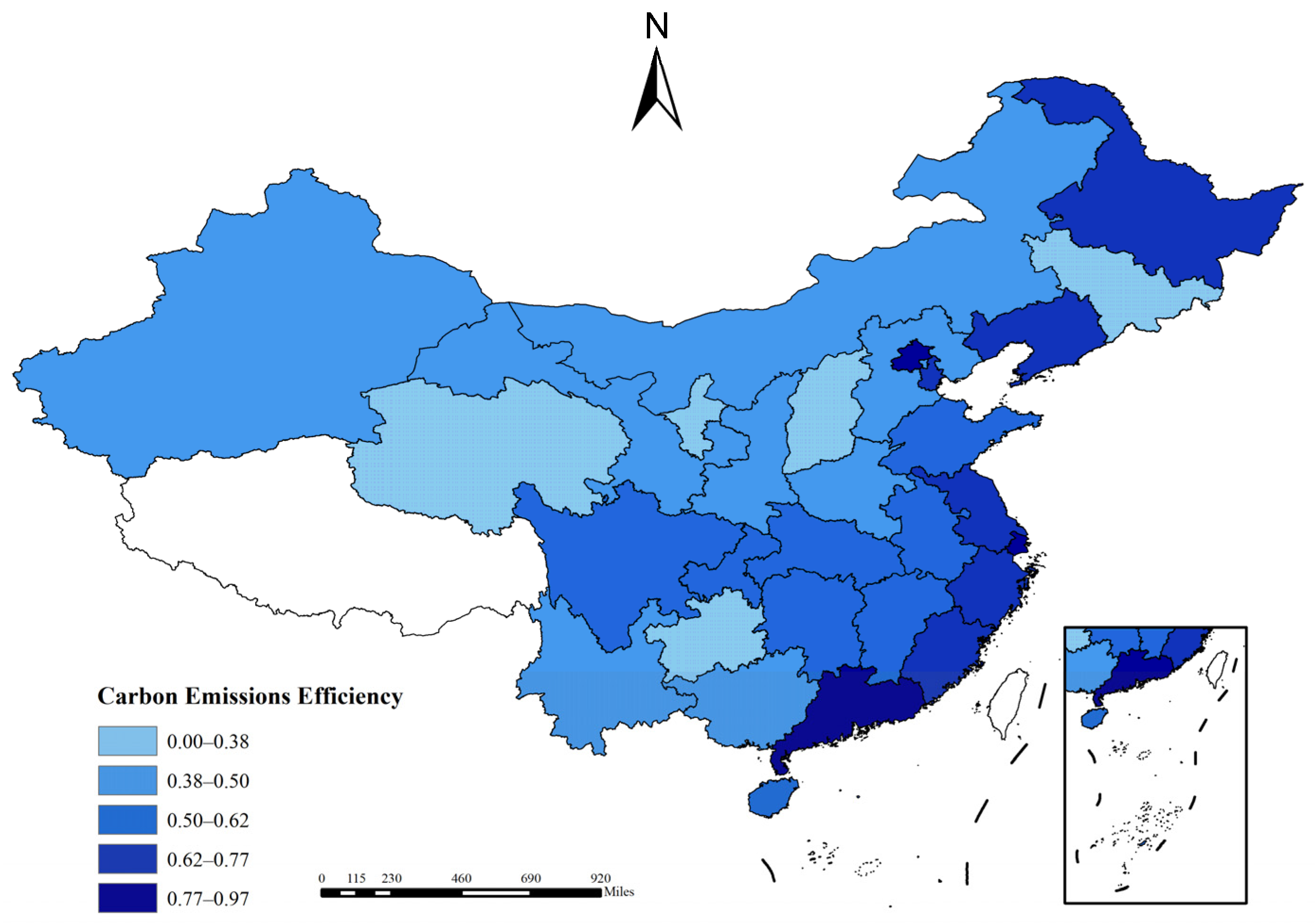
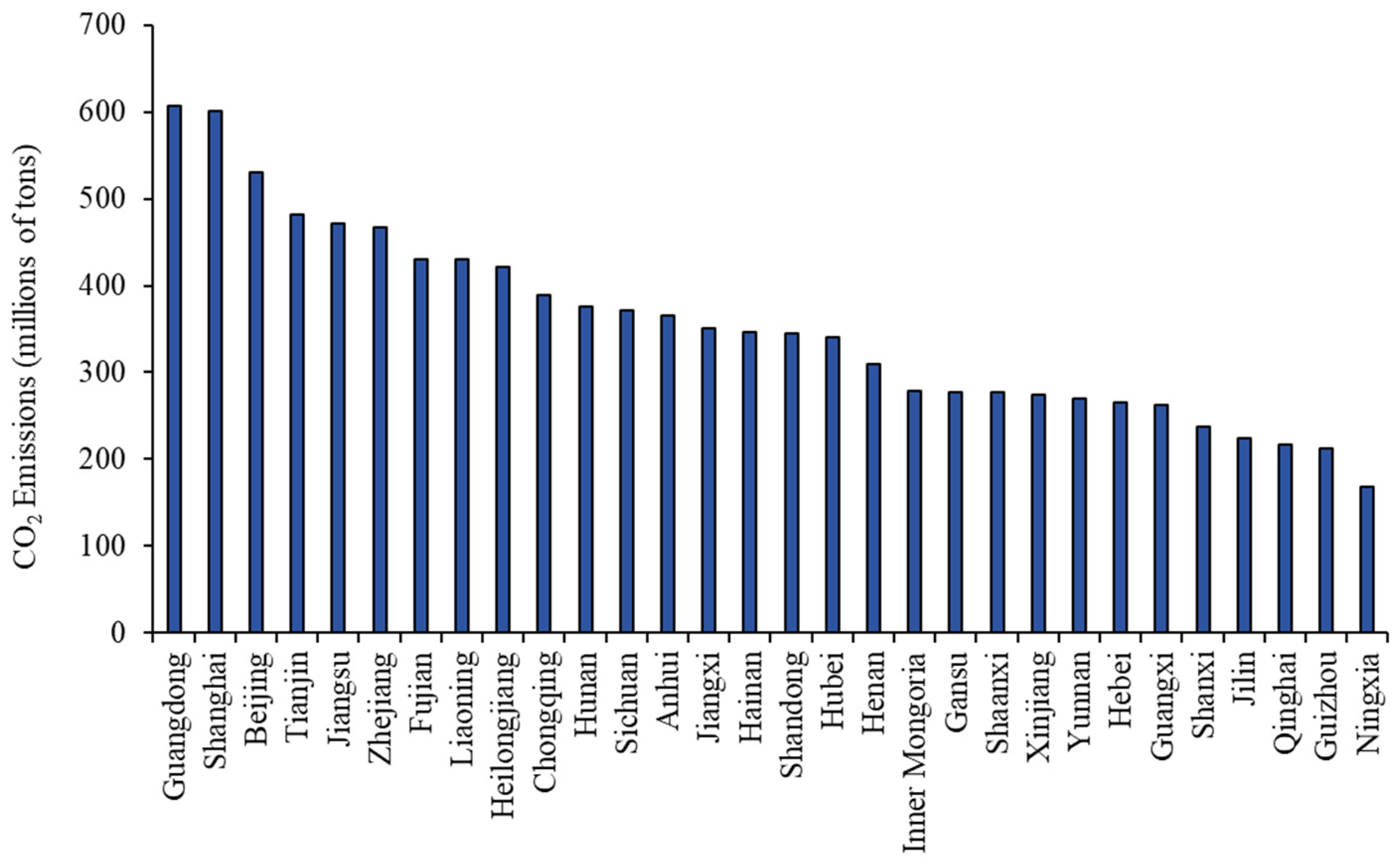
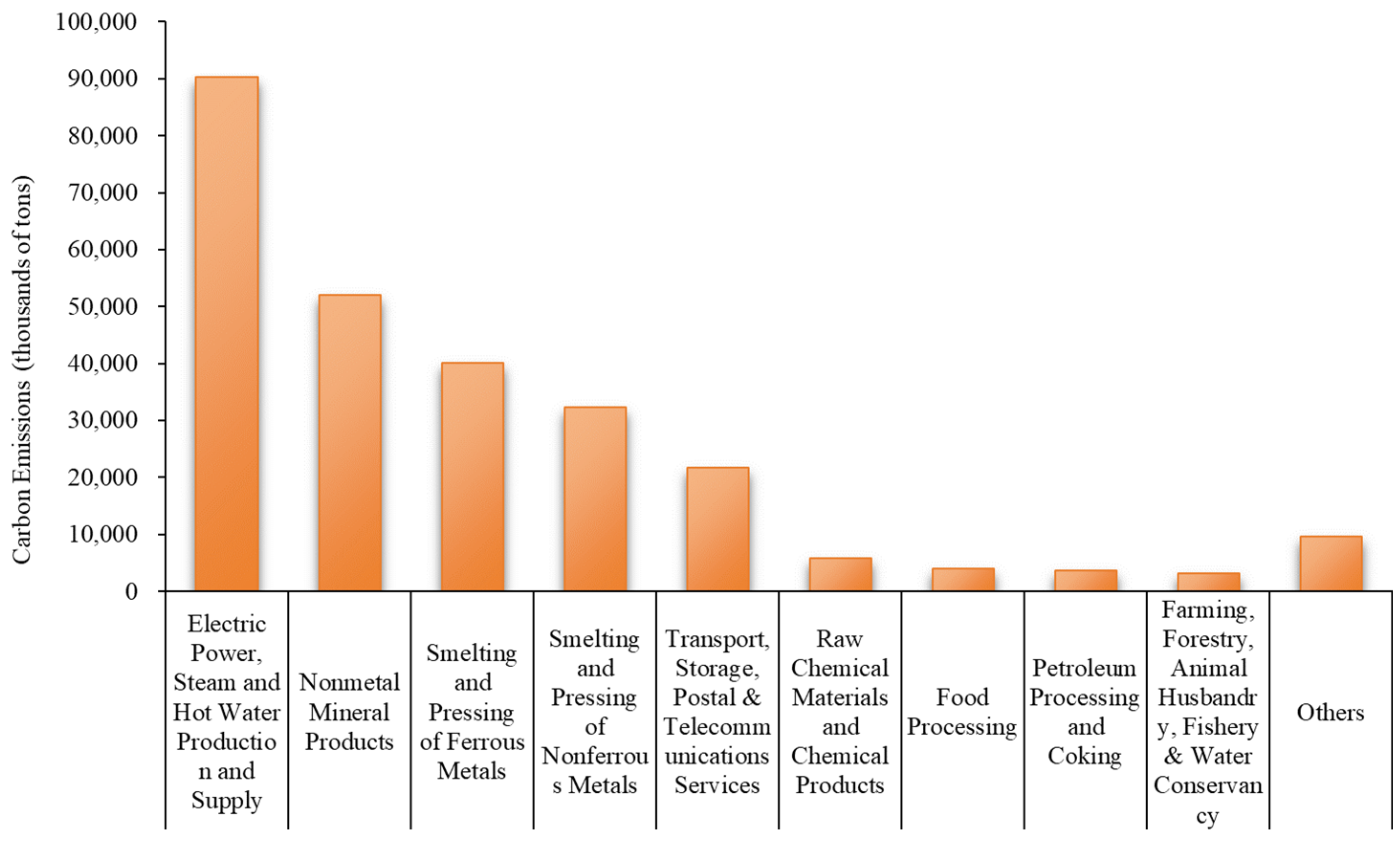

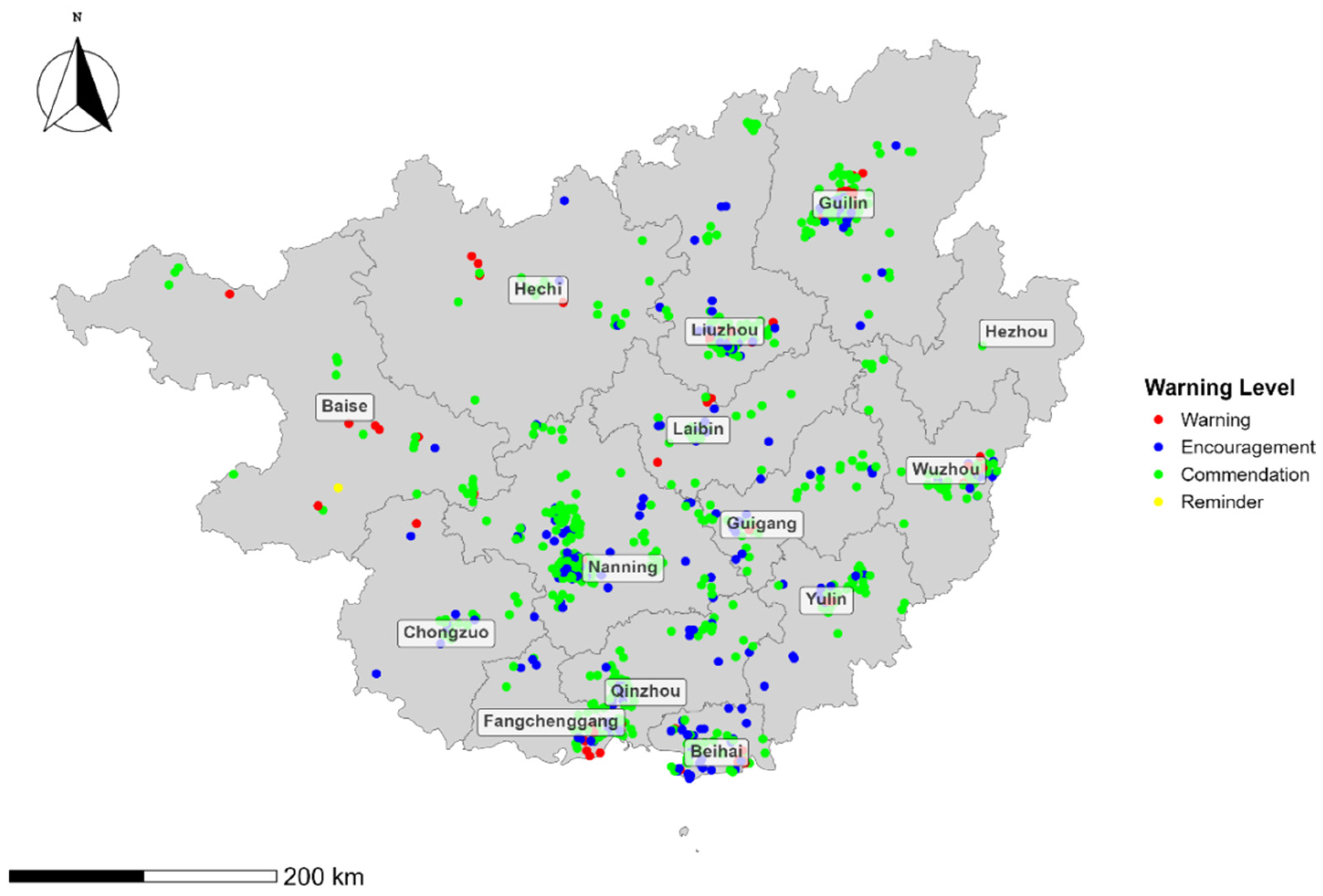
Disclaimer/Publisher’s Note: The statements, opinions and data contained in all publications are solely those of the individual author(s) and contributor(s) and not of MDPI and/or the editor(s). MDPI and/or the editor(s) disclaim responsibility for any injury to people or property resulting from any ideas, methods, instructions or products referred to in the content. |
© 2024 by the authors. Licensee MDPI, Basel, Switzerland. This article is an open access article distributed under the terms and conditions of the Creative Commons Attribution (CC BY) license (https://creativecommons.org/licenses/by/4.0/).
Share and Cite
Zhou, C.; Tang, H.; Zhang, W.; Qiao, J.; Luo, Q. A Big Data-Driven Approach for Early Warning of Enterprise Emissions Alignment with Carbon Neutrality Targets: A Case Study of Guangxi Province. Energies 2024, 17, 2508. https://doi.org/10.3390/en17112508
Zhou C, Tang H, Zhang W, Qiao J, Luo Q. A Big Data-Driven Approach for Early Warning of Enterprise Emissions Alignment with Carbon Neutrality Targets: A Case Study of Guangxi Province. Energies. 2024; 17(11):2508. https://doi.org/10.3390/en17112508
Chicago/Turabian StyleZhou, Chunli, Huizhen Tang, Wenfeng Zhang, Jiayi Qiao, and Qideng Luo. 2024. "A Big Data-Driven Approach for Early Warning of Enterprise Emissions Alignment with Carbon Neutrality Targets: A Case Study of Guangxi Province" Energies 17, no. 11: 2508. https://doi.org/10.3390/en17112508




